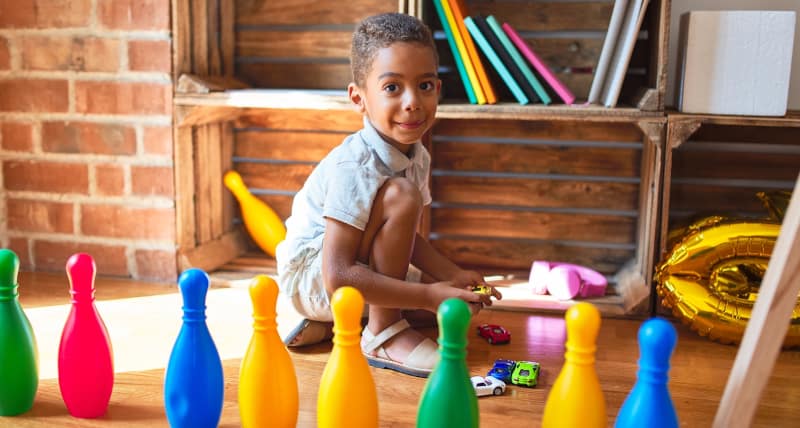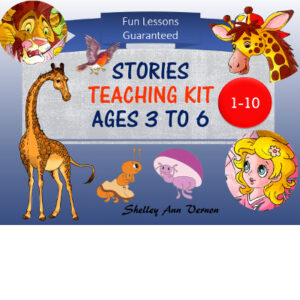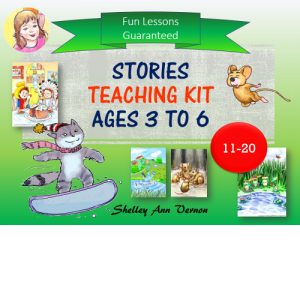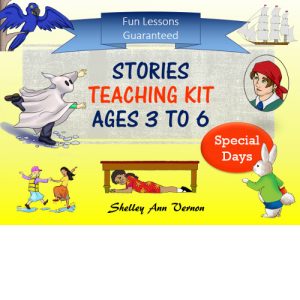This post covers aspects of child development and learning for four to six-year-olds acquiring English as a second or foreign language.
Brave new world !
It is quite a challenge for a small child to go out into the world alone!
Children aged 4-6:
– Are new to school
– Cannot analyze language yet
– Have limited motor skills
– Have limited reading and writing skills in L1
– Learn holistically
– And probably don’t see any reason to learn English!
They need reassurance
First, offer reassurance. To reassure your preschool pupils, smile, get down on their level, be gentle. Be patient while the children get to know you over several lessons.
Also reassuring is familiarity. So, use plenty of classroom routines, like opening and closing rituals, circle time, story-time, and familiar chants and songs. These are reassuring, all-inclusive group activities. In addition, use friendly toys and puppets as props.
So that children feel part of a family, group them at tables rather than using individual desks.
Break down the difficulty
For effective child development and learning, help your learners by breaking down their challenges into easier chunks. Since 4-6-year olds cannot analyze language yet, so there is no point in attempting to explain grammar or parts of speech. Instead, teach vocabulary and chunks of language. For instance, whole phrases like How are you? and the reply, I’m fine thanks, are perfect.
Rhymes, songs, and chants are reassuring to kids because they can join in without feeling vulnerable; they can pick them up gradually through many repetitions, join in with meaningful actions, and create a bond with the group through this communal experience.
Chants are fun and easy to make up. For a sure-fire success, invent chants with your pupils as characters in the chant. For example, Here is Juan, he likes football, kick a ball, kick a ball, kick, kick, kick. Here is Mercedes, she likes music, sing-a-long, sing-a-long, sing, sing, sing.
Have all kids join in with the actions for each person. You will see how chuffed they are when it is their turn!
Songs
Songs are brilliant teaching tools. Kids can pick up chunks of language, participate through actions and play games to music. A classic song like ‘Old Macdonald Had a Farm’ has been a hit since it was composed in 1917! Wow, over 100 years later, this folk song isn’t even out of date! I guess farms, cows, sheep, pigs, and horses are common worldwide. This song is handy for long-vowel sounds, like moo, baa, and ee-i-ee-i-o. My own version of this classic song is a great improvement on some of the soulless plinkety-plonk renditions online. And I always laugh in the final chorus with all the animals joining in enthusiastically!
Listen to this lively extract of Old MacDonald Had a Farm from Teaching English Songs Album 1
Use this song as background for musical games and fun song activities. You’ll find lots with this Song Album. In addition, play music in the background while kids do simple crafts like making farm animals typical for their country.
Avoid complicated crafts
Preschool kids’ motor skills are limited so avoid scissors and keep crafts simple; otherwise, you will be flat out doing the crafts for 26 kids yourself while everyone gets frustrated! On the other hand, colouring, gluing, and tracing around letters help children develop eye/hand coordination and fine motor skills; and they can get on with these on their own, leaving you free to supervise.
Go gently with reading and writing in English
Their reading and writing skills are limited in their native language, so rather than flogging them to read and write in English, it’s better to focus on listening and speaking activities. However, if teaching reading and writing is an obligatory part of the curriculum, then make sure that it is fun. For instance, use reading & word recognition games such as these:
- kids match written words to objects
- play musical word flashcards
- run and touch written words
- find another pupil with the same word
- draw words out of a box and sort them into piles
- spot the difference between two similar words
- act words.
Tracing over letters and words is an excellent way to gently introduce writing in English.

Motivation to learn English
At this age, children don’t understand that they are learning English to gain the capacity to communicate with more of the world’s population and perhaps have better employment prospects. In fact, they will see little reason to communicate in English. Playing games in English is a way of making this new language have meaning. Since 4-6-year-olds absolutely love playing games, this is a dead-cert way to get them interested in using English in class.
As well as learning English through games, kids will be learning to cooperate, be part of a team, take turns and follow the rules. However, I don’t recommend any form of competition at this age. It can be stressful and counter-productive. At this stage of their development and learning, children play for the sake of the game, not to win.
Don't sit back and turn the pages of a book
If you don’t involve your pupils actively in their learning, they will soon drift away. You’ll be abandoned, along with your book !
Children learn holistically through pictures, movement, sound, music, singing, touch, textures, stories, imagination, pretend play, fun, exploration, and games. Sitting in front of a book isn’t going to cut it! Stories are always popular, and especially popular are stories about animals. Children should get involved in the story-telling by acting the animals, making animal noises at appropriate moments, and using cuddly animal toys as story characters. These toys only speak English, and thus give the kids a real reason to communicate with the toy in English.
Fantastic preschool resources to make your life easy
Any of my story teaching kits are ideal for child development and learning.
Just follow the lesson plans and you’ll have all the ingredients to capture the attention of your class.
Each kit has:
– flashcards,
– games,
– stories,
– lesson plans and role-play ideas and,
– powerpoints with audio by native speakers.
– Matching songs with masks of story characters are available too !
Follow along and you’ll be a great success! Plus, your kids will learn English, enjoy it and like you as a teacher. Please find links to a choice of kits here.
-
Preschool
ESL Preschool Stories 1-10 Teaching Kit + PowerPoints
Rated 0 out of 5$47.96Original price was: $47.96.$35.20Current price is: $35.20. Add to cart -
Preschool
ESL Preschool Stories 11-20 Teaching Kit + PowerPoints
Rated 0 out of 5$47.96Original price was: $47.96.$35.20Current price is: $35.20. Add to cart -
Preschool
Special Days Stories Teaching Kit + PowerPoints
Rated 0 out of 5$47.96Original price was: $47.96.$35.20Current price is: $35.20. Add to cart
If you like this post on child development and learning, do check out my great stories and games to make teaching 4-6 year-olds English easy and fun.




4 thoughts on “Child development and learning ages 4-6”
Hi there. I’m wondering about the timing for one ESL session for preschoolers aged 2-6. Is there recommended time for that?
Thanks in advance
Hello there Vito, Thanks for your message. Half an hour is enough for toddlers usually. However 6-year-olds can work constructively for an hour no problems. If you do longer sessions, then that’s possible using breaks and a variety of activities.
If you are planning to teach toddlers to six-years-old in one sitting, then that’s quite a challenge! You’ll need either an assistant or parents for the toddlers. You won’t be able to do it all yourself. I mean, how do you constructively teach an older child when a toddler is screaming or having a tantrum?!
Here’s a blog on mixed clases with some tips!
https://teachingenglishgames.com/teaching-mixed-age-groups/
All the best, Shelley
Hello, I’m a new teacher of English, teaching ESL for kids ( 5-8 ) and the 5 yo kid has speaking problems, he doesn’t even speak his first language properly. I was wondering how can I manage the lessons in this situation, should I keep it at his level or the others’ level?
Also, what can you advise me to do to deliver my lessons to them?
Hello there and thanks for your question. You cannot go at the level of the slowest student or the others will get bored, and they deserve better. Go at the pace of the majority and when it’s the 5-year-olds turn, ask him really easy questions that he knows. This way he participates, but on his level. If he can’t speak, have him respond by pointing to things-flashcards-colours rather than naming them. he can still join in games and songs, doing the actions, even if he does not say much. It’s important that he enjoys English because you don’t want to put him off the topic for life. So, even if he cannot demonstrate having learned that much, he should enjoy coming to class and feel confident about the few words he can say. Parents will just have to be patient, or pay for private lessons. You cannot realistically expect to teach 5 and 8-year-olds in the same class and go at the pace of the 5-year-old !
Here is a post with more ideas on mixed age classes. https://teachingenglishgames.com/teaching-mixed-age-groups/
From my resources I do recommend my book of skits. The older kids can have bigger roles. The 5-year-old can have one or two easy lines and participate in all the acting. You can get the plays in paperback from Amazon or in my shop as a download. I have used them with as young as four and five though one does go very gently at that age. Here is a link: https://teachingenglishgames.com/product/plays-and-skits-for-kids/
Feel free to ask me more questions, I’m here to help !
Kind regards
Shelley Ann Vernon